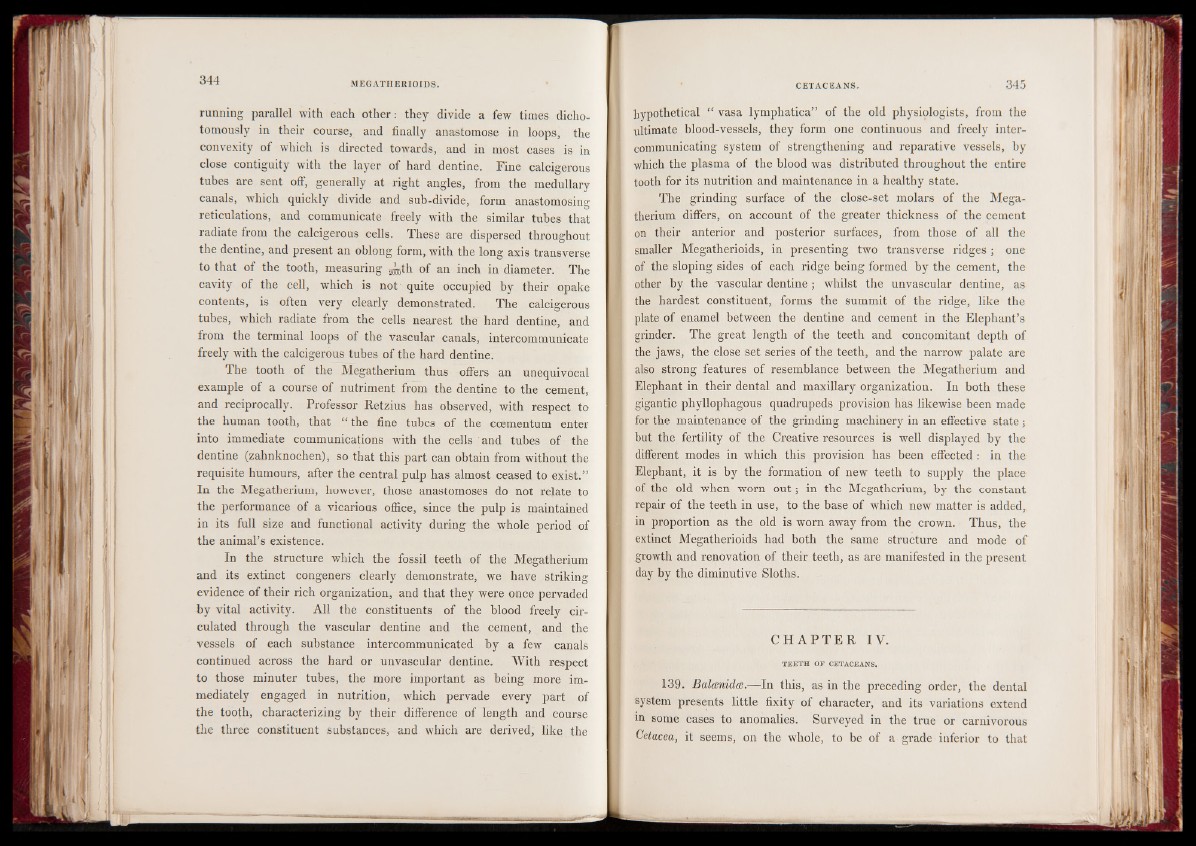
running parallel with each other: they divide a few times dicho-
tomously in their course, and finally anastomose in loops, the
convexity of which is directed towards, and in most cases is in
close contiguity with the layer of hard dentine. Fine calcigerous
tubes are sent off, generally at right angles, from the medullary
canals, which quickly divide and sub-divide, form anastomosing
reticulations, and communicate freely with the similar tubes that
radiate from the calcigerous cells. These are dispersed throughout
the dentine, and present an oblong form, with the long axis transverse
to that of the tooth, measuring i t h of an inch in diameter. The
cavity of the cell, which is not- quite occupied by their opake
contents, is often very clearly demonstrated. The calcigerous
tubes, which radiate from the cells nearest the hard dentine, and
from the terminal loops of the vascular canals, intercommunicate
freely with the calcigerous tubes of the hard dentine.
The tooth of the Megatherium thus offers an unequivocal
example of a course of nutriment from the dentine to the cement,
and reciprocally. Professor Retzius has observed, with respect to
the human tooth, that “ the fine tubes of the ccementum enter
into immediate communications with the cells and tubes of the
dentine (zahnknochen), so that this part can obtain from without the
requisite humours, after the central pulp has almost ceased to exist.”
In the Megatherium, however, those anastomoses do not relate to
the performance of a vicarious office, since the pulp is maintained
in its full size and functional activity during the whole period of
the animal’s existence.
In the structure which the fossil teeth of the Megatherium
and its extinct congeners clearly demonstrate, we have striking
evidence of their rich organization, and that they were once pervaded
by vital activity. All the constituents of the blood freely circulated
through the vascular dentine and the cement, and the
vessels of each substance intercommunicated by a few canals
continued across the hard or unvascular dentine. With respect
to those minuter tubes, the more important as being more immediately
engaged in nutrition, which pervade every part of
the tooth, characterizing by their difference of length and course
the three constituent substances, and which are derived, like the
hypothetical “ vasa lymphatica” of the old physiologists, from the
ultimate blood-vessels, they form one continuous and freely intercommunicating
system of strengthening and reparative vessels, by
which the plasma of the blood was distributed throughout the entire
tooth for its nutrition and maintenance in a healthy state.
The grinding surface of the close-set molars of the Megatherium
differs, on account of the greater thickness of the cement
on their anterior and posterior surfaces, from those of all the
smaller Megatherioids, in presenting two transverse ridges; one
of the sloping sides of each ridge being formed by the cement, the
other by the -vascular dentine ; whilst the unvascular dentine, as
the hardest constituent, forms the summit of the ridge, like the
plate of enamel between the dentine and cement in the Elephant’s
grinder. The great length of the teeth and concomitant depth of
the jaws, the close set series of the teeth, and the narrow palate are
also strong features of resemblance between the Megatherium and
Elephant in their dental and maxillary organization. In both these
gigantic phyllophagous quadrupeds provision has likewise been made
for the maintenance of the grinding machinery in an effective state ;
but the fertility of the Creative resources is well displayed by the
different modes in which this provision has been effected : in the
Elephant, it is by the formation of new teeth to supply the place
of the old when worn out; in the Megatherium, by the constant
repair of the teeth in use, to the base of which new matter is added,,
in proportion as the old is worn away from the crown. Thus, the
extinct Megatherioids had both the same structure and mode of
growth and renovation of their teeth, as are manifested in the present
day by the diminutive Sloths.
C H A P T E R IV.
TEETH OF CETACEANS.
139. Baleenidee.—In this, as in the preceding order, the dental
system presents little fixity of character, and its variations extend
in some cases to anomalies. Surveyed in the true or carnivorous
Cetacea, it seems, on the whole, to be of a grade inferior to that